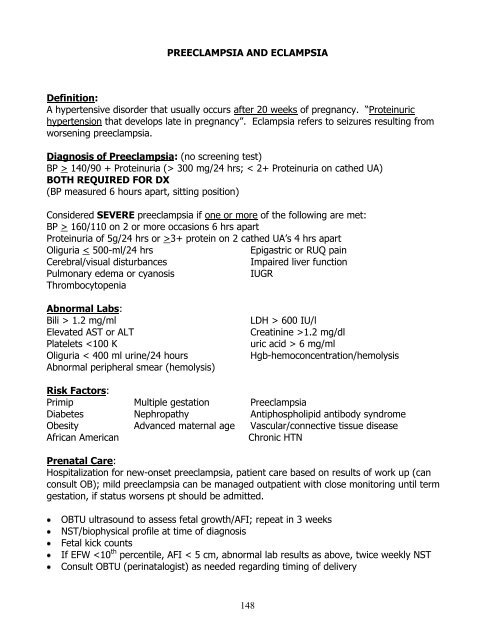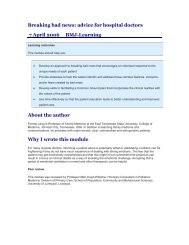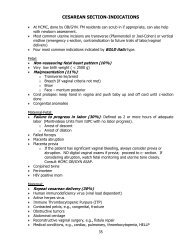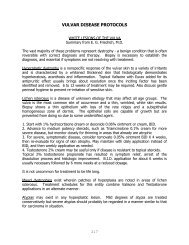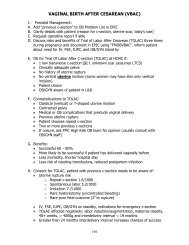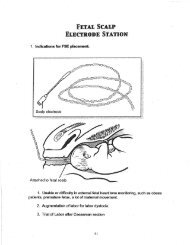Preeclampsia and Eclampsia
Preeclampsia and Eclampsia
Preeclampsia and Eclampsia
- No tags were found...
Create successful ePaper yourself
Turn your PDF publications into a flip-book with our unique Google optimized e-Paper software.
PREECLAMPSIA AND ECLAMPSIADefinition:A hypertensive disorder that usually occurs after 20 weeks of pregnancy. “Proteinurichypertension that develops late in pregnancy”. <strong>Eclampsia</strong> refers to seizures resulting fromworsening preeclampsia.Diagnosis of <strong>Preeclampsia</strong>: (no screening test)BP > 140/90 + Proteinuria (> 300 mg/24 hrs; < 2+ Proteinuria on cathed UA)BOTH REQUIRED FOR DX(BP measured 6 hours apart, sitting position)Considered SEVERE preeclampsia if one or more of the following are met:BP > 160/110 on 2 or more occasions 6 hrs apartProteinuria of 5g/24 hrs or >3+ protein on 2 cathed UA’s 4 hrs apartOliguria < 500-ml/24 hrsEpigastric or RUQ painCerebral/visual disturbancesImpaired liver functionPulmonary edema or cyanosisIUGRThrombocytopeniaAbnormal Labs:Bili > 1.2 mg/mlElevated AST or ALTPlatelets 600 IU/lCreatinine >1.2 mg/dluric acid > 6 mg/mlHgb-hemoconcentration/hemolysisRisk Factors:Primip Multiple gestation <strong>Preeclampsia</strong>Diabetes Nephropathy Antiphospholipid antibody syndromeObesity Advanced maternal age Vascular/connective tissue diseaseAfrican AmericanChronic HTNPrenatal Care:Hospitalization for new-onset preeclampsia, patient care based on results of work up (canconsult OB); mild preeclampsia can be managed outpatient with close monitoring until termgestation, if status worsens pt should be admitted.OBTU ultrasound to assess fetal growth/AFI; repeat in 3 weeksNST/biophysical profile at time of diagnosisFetal kick countsIf EFW
Management: (Epic order set available)Vitals:Q 15 mins x 1 hour, then Q 1 hour, including DTR’sActivity:Bed rest, quiet (i.e. one visitor at a time, limited TV)Nursing:Strict I’s & O’s, daily weights, seizure precautions, dip urine q shift forprotein, Foley catheter PMDiet:NPOIV:D5 NS @ 50 - 125/ Hr - WATCH THIS CAREFULLY**Meds: 10% Magnesium Sulfate 4-6 grams over 10-20 minutes IV load, then 2gms Q hour, dependent upon clinical pictureLabs:Magnesium level six hours after load, then Q6 hours until therapeutic,CBC with plts, LFT’s, BMP (Basic Metabolic Panel), Peripheral smear, +/-Uric Acid, +/- LDH. Repeat CBC with plts, LFT’s, PT, PTT q 4-12 hours,as clinical suspicion dictates.If low platelets, consider fibrinogen, d-dimer, PT, PTT (but remember,HELLP <strong>and</strong> DIC are not always the same thing. These labs may benormal, in spite of aspects of HELLP.)Extra:MgSO 4 caddy with 10% calcium gluconate (antidote), airway atbedsideMagnesium Monitoring:Follow patient carefully with clinical observation:8-12 reflexes disappear15-17 respirations decrease or cease30 -35 cardiac arrestHOLD Magnesium if reflexes absent or respirations < 10-12/min.For overdose, STOP Magnesium, start airway protection, oxygen, Calcium gluconate 1gm IVover 3 minutes, obtain EKG.Treatment Goals:1. Prevent seizures: magnesium sulfate IVRebolus of 2 gm IV if seizure occurs: If seizures continue, despite adequateMagnesium level, if absolutely necessary, the following may be considered:AVOID BENZODIZEPINES (Valium, Ativan) causes altered mental statusDilantin 10 mg/kg load, then 5 mg/kg two hours later, followed by 200 mgPO/IV q 8 hours, starting 12 hours after second bolus2. Control blood pressure: if BP > 160/105-110; gradually lowered with:Hydralazine 5-10 mg IV Q15-20 minutesORLabetalol (contraindicated for patients with asthma or CHF) 20 mg IV then Q 10minutes (40mg then 80 mg) until goal reached (max 220 mg total)DO NOY USE DIURETICS AS PATIENT HAS DECREASED INTRAVASCULAR VOLUME!149
Indications for Delivery:MaternalFetal1. 38 weeks gestation w/favorable cervix severe IUGR2. Platelet count < 100 K non-reassuring fetal tests3. Worsening liver function oligohydramnios4. Worsening renal function5. Suspected placental abruption6. Persistent headaches or visual changes (scotomata)7. Persistent midepigastric pain/vomitingProgress Notes:Assess for stability of condition <strong>and</strong> signs of toxicity. Vitals signs, urine output, total intake,toco, EFM, lungs sounds, heart sounds, reflexes, edema, magnesium rate <strong>and</strong> most recentlevel, labs (HELLP labs).Note should be written at least q 4 hours, with q 1-2 hour checks on patient. Watch fluidmanagement extremely carefully. Patients are usually total fluid up, but severelyintravascularly depleted. Fluid management is very tricky <strong>and</strong> tenuous.Post Delivery Management:Delivery is the treatment for eclampsia <strong>and</strong> preeclampsia. Postpartum preeclampsia usuallyresolves within 24 hours, but may persist for weeks (very unusual). Continue Magnesium for24 hours post delivery (longer if needed until increased urine output). If severepreeclampsia, continue to monitor labs q 6 - 8, otherwise q 24 is sufficient.Neonatal Management:Observe infant for hypomagnesemia, hypocalcaemia, respiratory depression, decreasedreflexes, drowsiness or ileus.References:NIH Working Group Report on High BP in Pregnancy July 2000.NHBPEP Report on High Blood Pressure in Pregnancy: A Summary for Family Physicians AFP7/15/01.ACOG Practice Bulletin, number 33, January 2002.FP Obstetrics, 2 nd Edition** See HCMC Labor <strong>and</strong> Delivery protocol for Administration of Magnesium Sulfate forTreatment of <strong>Preeclampsia</strong>/<strong>Eclampsia</strong>150


